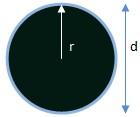
r: radius
d: diameter
A: Area
The area of a circle is given by:
A = Π ∙ r2 or A = Π ∙ (d/2)2
Π defines the ratio of any circle's circumference to its diameter and is approximately equal to 3.141593, however the value 3.14 is often used.
Example 1: The diameter of a circle is 16 inches. What is the lateral area?
Solution: A = Pi * r2
Radius = d/2 = 16/2 = 8
A = 3.14 * 82
A = 3.14 * (64)
A = 200.96 cm2
Example 2: From a circular sheet of radius 6 cm, a circle of radius 3 cm is removed. Find the area of the remaining sheet.
Solution: Here, outer radius, R = 6 cm
Inner Radius, r = 3 cm
Area of remaining sheet = Outer area - Inner area
= Pi * (R2 - r2)
= 3.14 ( 62 - 32)
= 3.14 (36 - 9)
= 3.14 x 27
= 84.78 cm2
Hence the area of remaining sheet is 28.26 cm2
Example 3: Find the radius of the circle when its area is known to be 56.52 square centimeters.
Solution: We know that the area of the circle is given by: A = Pi * r2
Isolating r we will get: r2 = A / Pi or r = √(A/Pi)
Thus:
r = √(56.52/3.14) = √(18) centimeters
Example 4: Vandana uses a lawn sprinkler to water the circular region of the lawn having 30 ft in diameter. Calculate the area watered on the lawn.
Solution:
Step 1: The shape of watered region is circular. Formula for area A = Pi * r2 where r is the radius of the circle.
Step 2: The diameter of the circular region is 30 ft i.e. r = 30/2 = 15ft
A = Pi * r2
= 3.14 * 152
=706.5 ft2
Example 5: Determine the area of a circle whose radius is 5 meter.
A = Π ∙ r2 = 3.14 ∙ 52 = 78.5 m2
Example 6: Determine the area of a circle whose diameter is 10 meter.
A = Π ∙ (d/2)2 = 3.14 ∙ (10/2)2 = 78.5 m2
Note that radius = diameter / 2